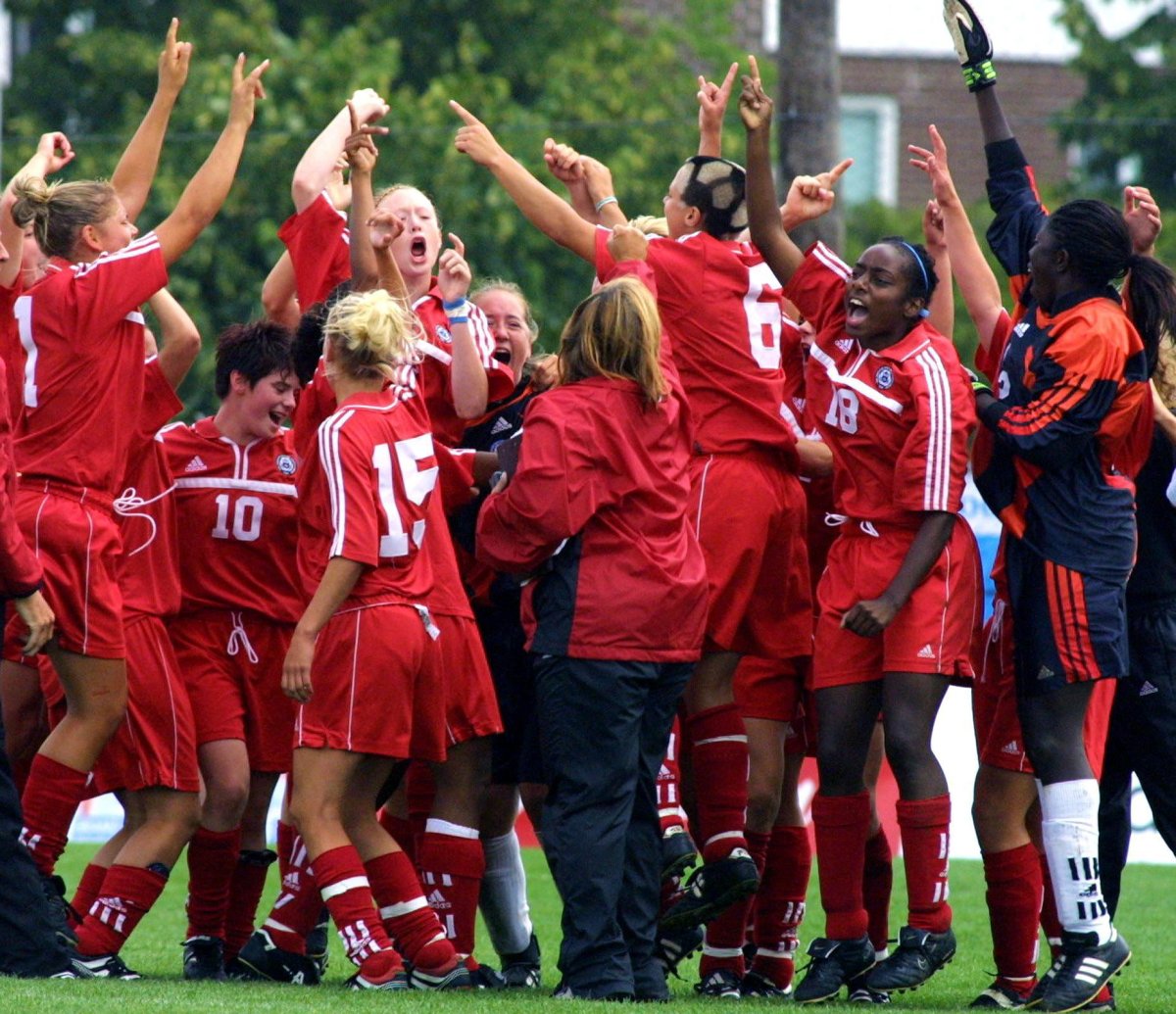Canada’s national sport is lacrosse.

Canada’s national pastime has long been considered hockey.
Canada’s biggest sport? For years it has been soccer.
No one has tabulated any 2017 numbers just yet, but the totals of some of the latest surveys, including the ones quoted by Canada Soccer are almost impossible for any other sport to top.
Lacrosse numbers are reportedly falling. Martin O’Neill fears that participation could drop below 30-thousand in the coming years.
Hockey is still very healthy with more than 600-thousand participants according to IIHF numbers, but not at the same level as soccer.
With nearly one million registered players, soccer can truly be found from coast to coast to border to coast in every province and territory.
And it’s time to have a look at the impact that the city of London is having provincially and nationally.
The easiest placed to start is with the National Women’s Team — the side that has captured back-to-back Olympic medals.
Take a look at the team picture, taken just after their bronze medal victory over host Brazil in Rio. There are 18 players kissing their medals. Two of them are from London: Shelina Zadorsky and Jessie Fleming. And they represent a huge piece of the future of the national program.
- Retired Quebec teacher buys winning lottery ticket at last minute, wins $40M
- N.B. election: Higgs went to ‘very dark place’ with Liberal joke, opponent says
- NDP want competition watchdog to probe potential rent-fixing by landlords
- Jasper mayor says CN Rail relocation will be devastating: ‘Deeply disappointed’
Zadorsky is only 24 and has been a part of the national team program since 2008. She also plays professionally for the Washington Spirit of the National Women’s soccer league. They are coming off a 1-0 victory on Saturday against Portland that was played in front of over 4,000 fans.
Jessie Fleming is just 19 and already has 65 caps for Canada. She is at UCLA, where this year, she scored 11 goals in 19 appearances.
And there are other players on their way up who may have a chance to kiss an Olympic medal someday.
So how does this happen?
Before you go testing to see if there is something in the London water, save yourself some time.
Dig into the programs that exist in the city.
From the London Football Academy to FC London’s Academy and beyond, players are being developed that are being recognized at the provincial, national and even international level.
Kaila Novak is just 15, but is a bright and shining part of FC London’s U21 team. She has just been named to Canada’s national Under-17 team. She is on the same path as Zadorsky and Fleming.
FC London president, Ian Fleming admits Novak’s rise has been fast, but her play has made it happen.
“Last year as a 14-year-old she actually played up with our U21 team and scored a goal in the final game of the year. She’s one of those players who when they see the net, you see it in hockey, you see it in basketball, when they see the net, they have a knack for scoring and she has that knack… She currently has eight goals in five games and that is as a 15-year-old playing against 21 year olds. Kaila really does stand out on the field.”
Players who are even younger are getting nods as well.

Get daily National news
Both Sophia Hladyniuk and Brandon Tam from London FA were selected to play for Team Ontario’s U14 squads. Logan Rieck was picked to play for Team Ontario’s U15s and then hit another level when he was named to a Team Canada identification camp roster.
London FA’s Logan Rieck was also selected as one of 38 players to participate in the Team Canada identification camp in February.
Jose Figueroa (better known as Garrincha) is one of the coaches at London FA. He made arrangements last year and this year for Watford FC coaches to come and help train players. Select players have then gone to train at Watford.
“The intensity and the way they play there is completely different,” says Garrincha. “They were able to train for two weeks. We were also able to take a team over and it would be nice to do that more often, but the cost and the logistics do not make it easy.”
Still, the training that exists and the reputation the London area has, keep it on the soccer radar. Campbell points to the attention London receives from the Canadian and American college and university level as a key.
“Mike Marcoccia, who coaches the FC London Women’s Under-21 team is also the coach at Fanshawe College, so that means that Mike is very ingrained with the up-and-comers province-wide. Martin Paynter is a scout for Toronto FC and is involved with Western’s women’s program. People here in the city have a good pulse on the college and university system and we really want to continue those relationships so that we can pass them on to players and their families.”
Find an NCAA soccer coach who comes to see a tournament and chances are they will have their eye on when the London team is playing. Experience has taught them that there are players to see based on what this area has always produced.
As much as London has had success producing players, the professional world is still a bit of a Fort Knox.
“It’s one in a million that makes it,” says Garrincha. “It’s very important to know that you have to have something very special. You can’t sell dreams.”
Londoners might remember the name, Paul Munster. He was born in Belfast, Ireland, but the late Harry Gauss brought him in to play for London City in 2004. Not long after that, Munster moved to Sparta Prague in the Czech league and continued a professional career in Europe until 2011, when he moved into management roles. Munster is currently with Orebro SK in the Swedish Allsvenskan.
He was that one in a million on the men’s side.
Zadorsky is now in her second season in the National Women’s Soccer League.
When asked about what may have helped her reach the heights she has in soccer, she points to the calibre of competition and coaching in the London area.
“What I loved about it was how competitive the players were and how seriously the coaches took their roles. I got to work with the Painters, Geoff and Martin, and also Dave Peak. They really instilled that passion and sight and Dave was so technical. The London soccer community continues to grow and it’s impressive what we continue to do and the players we produce.”
Zadorsky is not a veteran by any means, but has been joined by Fleming and admits it is incredible to think that the two of them have made it to the highest level of international soccer in Canada.
“It’s awesome to rep London and to watch Jessie’s success at such a young age,” Zadorsky adds.
The connections in the London soccer community that Zadorsky alludes to should not go unnoticed.
Campbell claims they may be one of the most important factors contributing to the successes the area has seen.
“I think one of the things is that we are now seeing a bigger opportunity for young men and young women to play against the best of the best.”
The next level has already arrived in the form of academies, like FC London Academy and London Football Academy that have players who go from very young ages all the way to their early 20s.
Campbell points to the Ontario Soccer Association and a pilot project called the OASL, the Ontario Academy Soccer League that is attempting to get all of the top academies in the province to play against each another.
Academies have been very popular in Europe for a long time and we see them in other sports as well. Jason Heyward was one of the first Major League Baseball players to come out of a baseball academy in the Atlanta area. The London Knights are affiliated with the Blythe Academy.
Campbell says that streamlining the message is very helpful for players.
“I think a big part of it is to really develop a pathway under a common focus and a common coaching philosophy. When you get a player at a young age… and you can put them into a stream, a consistent high-energy environment where they are going to get continually focused in the right direction.”
Campbell adds that they are noticing results already.
Both Campbell and Garrincha are quick to add that there can be ways to go places within the sport, but it isn’t a given.
“We try to help players become the best they can be,” Garrincha says. “Maybe there is a scholarship opportunity… At the younger ages it is about the experience.”
It is about installing and instilling a love for the game, something that has existed in London for a very long time.
Something that may just continue to give London and area soccer athletes a leg up in the sport.












Comments